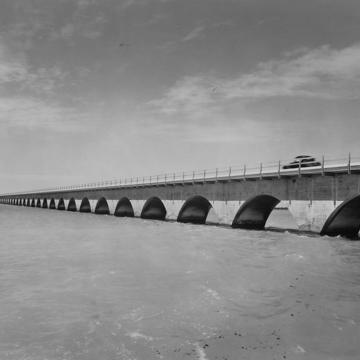Highway travel offered new social and political roles for the American motorist. New Dealers, in particular, sought to harness the political potential of the American traveler and created the Overseas Highway to Key West to test their theories. The Overseas Highway was the third largest Public Works Administration (PWA) project in the United States after the Hoover Dam and the Tennessee Valley Authority, and the largest and one of the last PWA roadway projects compleNV-01-SO51ted as part of the New Deal.
The history of the Overseas Highway is closely linked to that of Miami and Key West during the crisis of the Great Depression. The Florida Keys had been first linked by a continuous land route to Miami and points north by Henry Flagler’s Overseas Railroad in 1912. The railroad was severely damaged and hundreds killed during the Labor Day Hurricane of 1935. The combination of environmental challenges and the economic pressures caused by the Great Depression forced government officials to make a difficult decision to either abandon a land bridge to Key West and the lower keys or to transform it. Ultimately, it was decided that Key West would become a vacation destination for individuals specifically arriving by bus or car and the first leg on a larger journey around the Gulf of Mexico.
In early March 1937, contracts were written for work on a new Overseas Road and Toll Bridge District. Restructured beds for Flagler’s train tracks served as the foundations for a new two-lane automotive highway. Flagler’s original steel tracks themselves were reused as guardrails along the bridges. To connect existing roadways to the new automotive bridges, an additional 19.7 miles of coral reef was paved. The new automotive experience was anticipated to take only four or five hours (down from twelve hours by ferry) and opened the Florida Keys for the first time to a constant flow of tourists and automobiles.
Debates rages over how this influx of motorists would alter the Keys and their culture. Some thought that the island was a “Sleeping Beauty” waiting for the “magic touch of the overseas causeway.” Others questioned, however, whether Key West would retain “her slumbering charm,” when awakened by the annual flood of more than 100,000 automobiles expected to arrive on the new causeway. Many wondered whether the highway would be a “blight or a blessing…or both.” Part amusement ride, part tribute to modern engineering, the Overseas Highway allowed the motorist to float between the water and sky touching land wherever and whenever they wished.
On March 29, 1938, the 106-mile Overseas Highway officially opened a nonstop thoroughfare for motorists between Miami and Key West. One journalist for The Wall Street Journal, commented that the Overseas Highway was “the only highway in the world by which the motorist actually goes to sea in his car…[providing] one of the most unusual and scenic drives in America.”
In addition to its function as transportation infrastructure, the Overseas Highway was a part of a much larger social and cultural strategy developed around Roosevelt’s Good Neighbor Policy toward Latin America. According to reports at the time, the highway was only “the beginning of an even more ambitious and far-seeing highway program…with the ultimate aim of connecting the eastern section of the United States and Canada with Cuba, Mexico, and Central and South America.” As The New York Times reported, with “the opening of the Overseas Highway…the first critical step has been taken toward a motor tour through lands touching on the Gulf, which was the theatre of much of America’s early history.”
The highway was ultimately an attempt to unite areas of the Americas surrounding the Gulf of Mexico into a comprehensible American history. Tourists could now motor from modern Miami to cosmopolitan Havana, to the Yucatán Peninsula and past Mayan ruins, through sprawling Mexico City and Aztec ruins, across the lone star state of Texas, across Creole settlements of New Orleans, past America’s oldest city, St. Augustine, and back to Miami. The anticipated palliative force of the American highway traveler was harnessed through the Overseas Highway to the political ambitions seeking to dissolve international strife in the decade before World War II.
References
Stuart, John A., and John F. Stack, Jr., eds. The New Deal in South Florida: Design, Policy and Community Building, 1930-1943. Gainesville: University Press of Florida, 2008.

